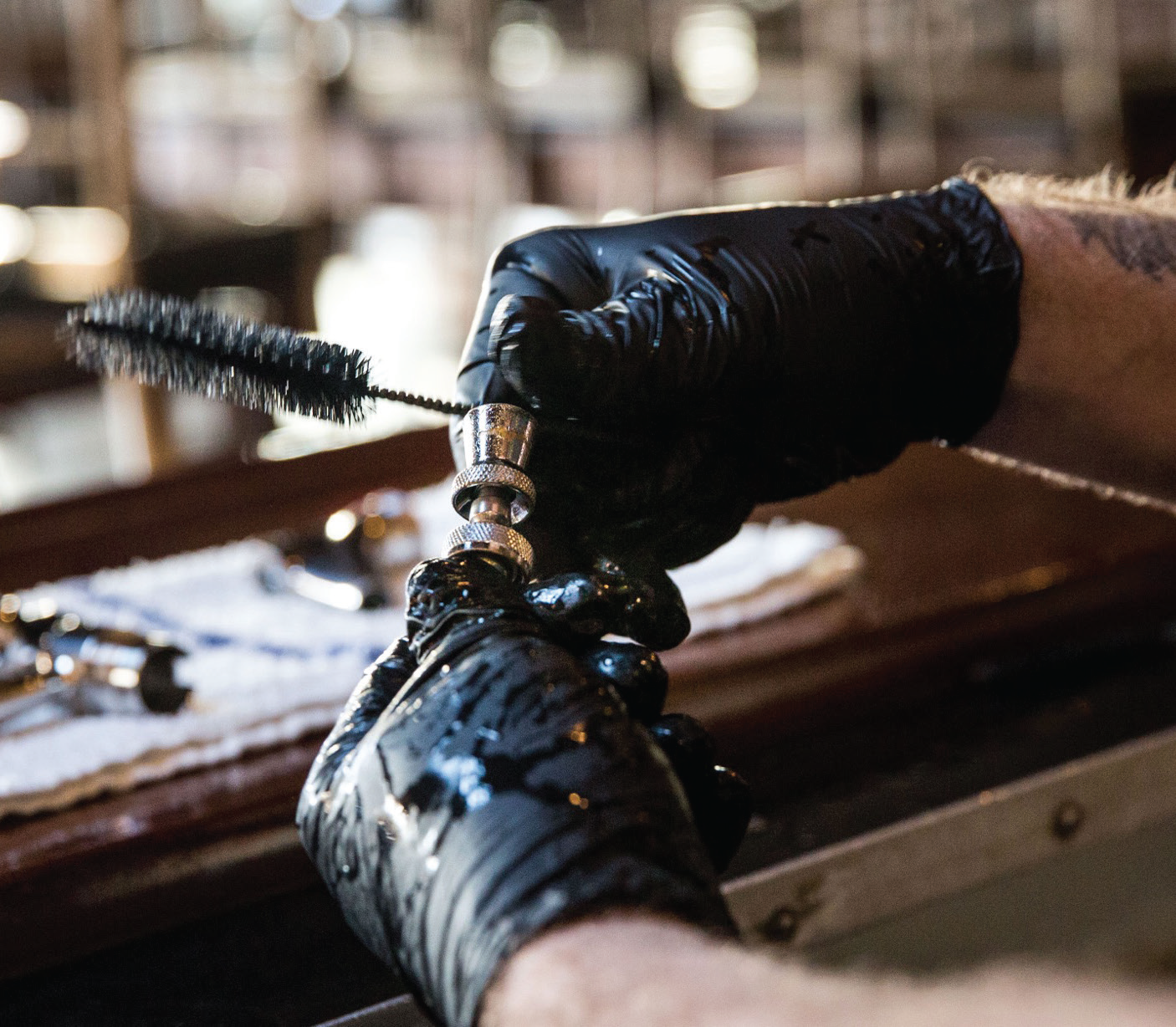There is a reason they do not make Super Bowl beer commercials about maintaining draft lines, sanitizing bottles and equipment, keeping the beer fridge stocked, and other preventative measures; it is boring. They do not even make dishwashing detergent ads for the big game. Who wants to talk about cleaning? There are no entertaining commercials about annual check-ups with the dentist, and scheduled maintenance advertising never wins a ‘People’s Choice’ award. Routine is ‘routine’ and people just are not that interested in it, but they should be.
By Chad Pilbeam – Contributor
There is nothing sexy or glamorous about maintaining a draft beer system. No one ever sells beer drinkers on ‘the brewing industry’s top sanitation measures.’ Instead, consumers are saturated with things like ‘choicest hops, premium malts, and experienced brew masters.’ For some reason, the people in the brewery marketing department think these words make beer taste better.
Maybe a catchy slogan and a clever advertising campaign will make people think the flavor of the beer is ‘premium’, but the reason beer is even drinkable in the first place is that someone who does not work in the marketing department did the boring, tedious, non-sexy job of maintaining the brew system. It is routine work that makes beer drinkable. Sorry to disappoint the marketing team at the brewery, but maintenance makes beer taste way better than any adjective, even if it is a ‘citrusy explosion of hoppy grapefruit aroma balanced with a robust malty backbone and silky mouthfeel.’ Sounds delicious, right? Well, none of those flavors are present without proper maintenance.

Importance of Maintenance
A brewmaster will state that ‘cleanliness is next to holiness.’ If the equipment is not maintained, selling beer will not be a problem because beer that cannot be consumed, cannot be sold. In the valve industry, an experienced and professional operator or field technician will state that a lack of maintenance on an industrial valve results in reduced efficiency, increased leaks, and a higher safety concern. Whether it is in a brewery or with an industrial valve, neglecting maintenance just leaves ‘a bad taste in the mouth.’ This shared concern on maintenance practices is why “Everything I need to know about valve maintenance, I learned from beer.”
An industrial valve project is comparable to a three-legged bar stool. There are three legs that make up the foundation of a successful project; valve selection, installation, and maintenance.
Choosing the appropriate valve for the application is the first of the three legs. With so many application-specific valves, manufacturers spend significant time selecting the most appropriate materials and type of valve. The installation of the valve is a skill, and when aided by technology and engineering, is precise. Of course, precision goes to performance; the more precise the proper installation is, the better the operation of the valve. The final leg of this proverbial ‘bar stool’ is maintenance. Maintenance serves to preserve the integrity of the correctly selected and installed valve but is often overlooked because it is not as visible or as easily noticed.
When buying or selecting a new valve, multiple departments are involved to ensure it will meet the required specifications; is often the genesis of a project. When installed, there are multiple parties privy to the application and anticipate the valve going into use. Once the valve is selected, installed, and performing at a high level, the technicians involved in this project set their sights on the next obstacle or assignment. Maintaining that valve is a ‘down the road’ project for ‘someone else’ to attend to.
This is not to suggest that people do not care about maintenance, or that people will deny the need for it. No professional with an understanding of a valve’s importance would ever say, “Yeah, we do not need to do anything until that valve fails.” Just like no self-respecting bar or brewery would ever say, “We will clean the tap lines when someone complains about how bad the beer tastes.” Preventative maintenance is essential to the integrity of the asset. Whether one is serving a pint or ensuring the proper flow of media in a pipeline, they never want to be in the position of saying “Yeah, we decided not to do the scheduled maintenance” when something goes wrong.
The Dangers of Overlooking Preventative Maintenance
Should a brewhouse become contaminated it is possible that many batches of beer will be poured down the drain. In extreme cases, cans and bottles have exploded from a lack of cleanliness. In more extreme examples, when maintenance was not adhered to, breweries have been responsible for the death of a beer drinker.
The consequences of unmaintained industrial valves include fugitive emissions, lower productivity, increased energy costs, potential environmental impacts, legal exposure, and reduced safety for employees and the public. No matter how low the probability or statistical likelihood of a ‘worst-case scenario’, recommended maintenance is called “recommended,” as it helps mitigate the risk of a worst-case scenario.
While it may seem obvious that preventative maintenance has several benefits, many individuals question why there is a persistent need to revisit the topic. The reason it is revisited is the same reason reminders are sent to go visit your dentist or change the oil in the car – it may be known, but it still gets overlooked. It is therefore beneficial to use beer to raise awareness.

Remember that no one notices when maintenance is performed, but when maintenance is not performed, everyone notices. In the same way, if an individual goes to the dentist no one sees the difference but skip the dentist and people will notice bad teeth.
Total Costs
Preventative maintenance is scheduled and calculated. The expense is anticipated and well documented. From a budgeting perspective, this is a fantastic advantage and reason to perform these routines. The downside is that when budgets need to be trimmed, maintenance is often sacrificed. The decision to cut maintenance offers short-term savings and a hope that there is no long-term consequence. Sure, this improves the direct costs of maintenance, but the indirect costs must be considered as well.
The downtime cost of an industrial valve is difficult to calculate given the variables of application, media being transferred, and type of valve. It does however have an expense, which is usually kept separate from the maintenance or lifetime cost of the valve. If one adds the cost of the downtime to the valve maintenance budget, the benefit of routine maintenance is easily justified.
There are two things more costly than downtimes: unexpected downtimes, and catastrophic failure. By performing routine maintenance, the individuals responsible for visually inspecting the valve can establish predictive maintenance procedures. Predictive maintenance differs from preventative in that those maintaining the valve can anticipate when a repair might be necessary and can schedule repairs to avoid the more expensive unexpected downtime. As for a catastrophic failure, this results in a combination of unexpected downtime, unknown costs to resolve, legal exposure, and potential environmental impact.
To stay healthy and drink beer, regular exercise is needed even if the days of six-pack abs are long gone. Experts, therefore, suggest that maintenance personnel routinely check the seating of the valve, inspect the gaskets, look for signs of corrosion, and clean the valves. They also suggest following the lubrication and packing requirements, performing routine torque checks, and opening and closing them frequently to ensure proper working function and to minimize sticking, noise, debris buildup, and corrosion. Despite maintenance being a cost center and expense to the company, the result is savings to the operator and owner over the lifetime of the valve.
Follow Best Practices
‘Quality’ is a word companies often like to use, but can it be substantiated? If industry best practices are adhered to, industry best results will prevail, and ‘quality’ is substantiated. Just because a bottle of beer reads ‘Premium’ on the label, does not mean the brewer did not use cheap ingredients, take shortcuts in the brewing process, or strip flavor and substance through filtering. If every brewer claims to have an excellent or ‘premium’ product, how does a truly premium brewery differentiate?
For industries that rely on industrial valves, the selection, installation, and maintenance all identify the quality of the asset. Selection is a choice, installation is a skill, and maintenance is a decision. Beer drinkers do not make the decision to drink the most poorly made beer; valve experts should likewise not allow valves to be the most poorly maintained. No one chooses to be the operator of poorly maintained valves; they just choose to not perform the preventative maintenance and end up with them. Maybe they chose that after all.
What does it take to be the best? What does it take to stand out? Beer in many ways is a commodity and brewers are finding it harder and harder to differentiate. Imagine if a consumer discovers that the brewer does not have strict procedures, that they do not treat their water, fail to maintain proper temperatures, or do not subscribe to the brewer’s mantra of ‘cleanliness is next to holiness’. They would not be surprised when bad beer is brewed or served, on account of insufficient maintenance. Should anyone in the world of industrial valves be surprised by an unexpected shutdown or poor performance when maintenance is not performed? The simple answer is no.
To the workers who perform routine and predicted maintenance on industrial valves in accordance with the data and recommendations, you have earned the right to use ‘quality’ when describing your work, and you have earned a beer. To those ignoring the maintenance, do not even think about putting ‘premium’ on your ‘label’, and you can have a beer after you are done checking up on those valves!



